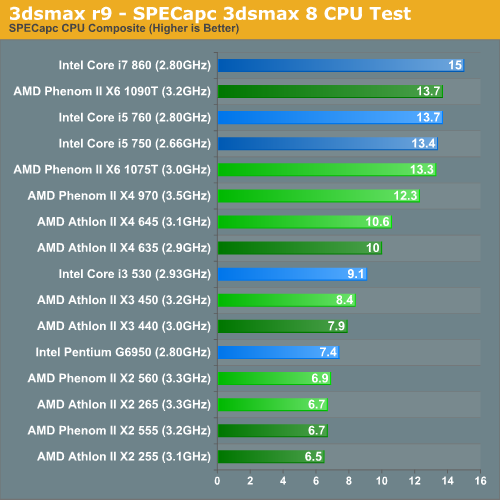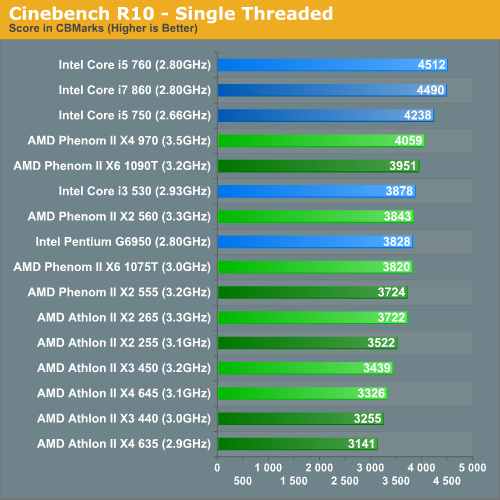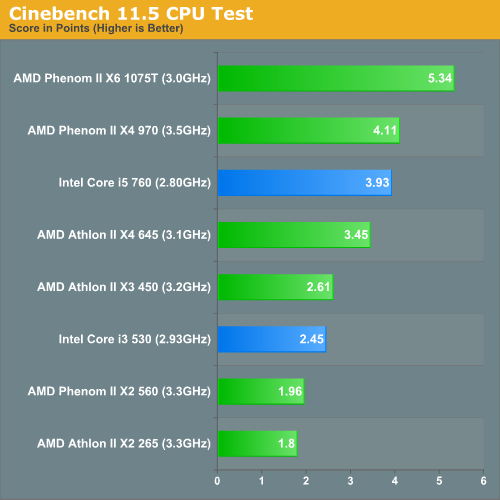AMD's Fall Refresh: New Phenom II and Athlon II CPUs Balance Price and Performance
by Anand Lal Shimpi on September 21, 2010 2:52 AM EST- Posted in
- CPUs
- AMD
- Phenom II X6
- Athlon II
3dsmax 9 - SPECapc 3dsmax CPU Rendering Test
Today's desktop processors are more than fast enough to do professional level 3D rendering at home. To look at performance under 3dsmax we ran the SPECapc 3dsmax 8 benchmark (only the CPU rendering tests) under 3dsmax 9 SP1. The results reported are the rendering composite scores.

The 1075T comes close to its competitors in the 3dsmax test, while the Phenom II X4 970 definitely falls short.
The quad-core Athlon II X4 645 does much better than the dual-core i3 530 (and by extension the 540). The same holds true for the Athlon II X3 450 vs. the Pentium G6950.
Cinebench R10
Created by the Cinema 4D folks we have Cinebench, a popular 3D rendering benchmark that gives us both single and multi-threaded 3D rendering results.

Single threaded performance is AMD's weakest point. Even at 3.5GHz the Phenom II X4 970 can't keep up with a turboed Core i5 750. If you run a predominantly single threaded workload, Intel will typically offer you better performance than AMD.

Turn up the thread count however and the value proposition shifts to AMD. The Phenom II X6 1075T gives you more for your money in a heavily threaded app than the Core i7 860, and the Phenom II X4 970 is a smidge ahead of the i5 750. The Athlon II X4 645 and Athlon II X3 450 both do very well.
I've started running Cinebench 11.5 in preparation for an update to Bench, some of the initial results are below:

The default benchmark is heavily threaded. As a result the scores echo what we just saw.










98 Comments
View All Comments
iwodo - Tuesday, September 21, 2010 - link
All these Athlon II and Phenom, are expected to complete against Sandy Bridge next year?( Since Bulldozer are not coming to Fusion type and low end CPU )
SandyBridge is coming to kick some ass then by the looks of it. Higher IPC, Higher Clock speed, lower Idle power, better Hyper Threading......
Apart from Fusion i am not excited by AMD's roadmap at all.......
Dark_Archonis - Tuesday, September 21, 2010 - link
I believe Llano is supposed to compete with Sandy Bridge, but the problem is Llano is coming to market later than Sandy Bridge. Until Llano comes, yes these Athlon IIs and Phenom IIs will be forced to compete with Sandy Bridge, and they are going to lose badly.Even when Llano comes, it's not supposed to be a big performance increase, so I think Sandy Bridge will rule the mainstream market.
As for Bulldozer, it will have to go up against Intel's socket 2011 Sandy Bridge models that are likely to be without integrated graphics. These models are rumored to have up to 8 physical cores, 40 lanes of PCI-E 3.0, and quad-channel DDR3.
Eeqmcsq - Tuesday, September 21, 2010 - link
On the Video Encoding & Data Archive page, the graph for Par2 is in reverse. It has the Athlon II X2 255 at the top and the Core i7 860 at the bottom.Makaveli - Tuesday, September 21, 2010 - link
Eeqmcsq the graph is correct.Look under the heading of the graph....
(Lower is better)
Eeqmcsq - Tuesday, September 21, 2010 - link
Yes, I saw that. But Anand usually puts the best CPU at the top, not at the bottom. See the previous review for the Core i7 970.http://www.anandtech.com/show/3833/intels-core-i7-...
hangfirew8 - Tuesday, September 21, 2010 - link
You write: "The Phenom II X6 1075T is an interesting chip as you get a lot of compute but it's only useful in heavily threaded apps."I strongly disagree, unlike you are calling virtualization "apps".
These chips are a godsend to developers, testers and sales who are running entire tiles of software. Need to test your client on XP, Vista and Windows 7? Need to run a web application server on Windows and an Oracle database backend on Linux? Need to do all of these at the same time? This is what a Hex Core chip is made for, not running a single heavily threaded app on a single O/S.
I'd like to see an AT Bench benchmark that covers this sort of application. I'd like to see how comparably priced Intel CPU's do versus AMD chips. I'm thinking this would be a huge differentiator between HyperThreading and actual cores, but I'd like to see the numbers before making any claims.
haplo602 - Tuesday, September 21, 2010 - link
this is not quite comparable. on moderately IO dependant workloads (your web server/oracle db example), HT will do just fine. on compute dependant applications with little memory access, HT will bottleneck. However you will hardly run 4-6 compute dependant VMs at once every time.hangfirew8 - Wednesday, September 22, 2010 - link
I agree on your HTT assessment.BTW I mean "unless" not "unlike". Where's the edit button?
Can I get a reply from AT on VM? Can we stop treating every desktop chip as a gaming candidate-only chip and get some kind of desktop VM benchmark going here?
I'm thinking running one per VM: compile/link/install (push application from dev VM to web server VM over virtual network), web server with integrated JAVA application, three web clients, and a database backend. Run a mix of Linux & Windows, 32 and 64 bit O/S's. The app being compiled doesn't even have to be the app being run.
Accord99 - Tuesday, September 21, 2010 - link
There's some tests done by the IT side of Anandtech:http://www.anandtech.com/show/2774/10
Relatively speaking, more cores offers a bigger boost than Hyperthreading, but a single Nehalems core is much more powerful than a AMD K10 core.
hangfirew8 - Wednesday, September 22, 2010 - link
Yes I know they can do it, but we have no data on how similarly priced desktop chips compete. HTT versus Cores is only one aspect. I want to see the AMD hex chips stretched against Intel quad cores in VM's and shake out the bang for buck. AT's attitude about hex cores only being useful for single heavily threaded apps just doesn't match how this chip is being marketed or how it is being used in the field.AT should realize that a lot of their PC gaming readers have daytime jobs not just as server administrators, but as software developers and testers. Management comes to us for advice and no one is providing us with the data to make informed decisions. 7Zip benchmarks are fine but give us a software development lifecycle benchmark using VM's, give us data on what we are already working with for several years in real life (work). Give us a benchtop VM benchmark! Please!